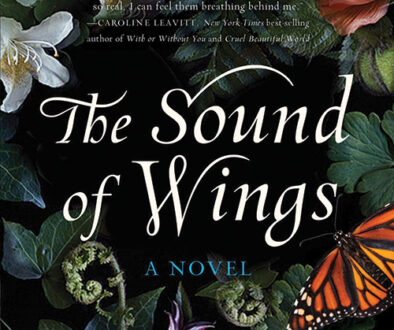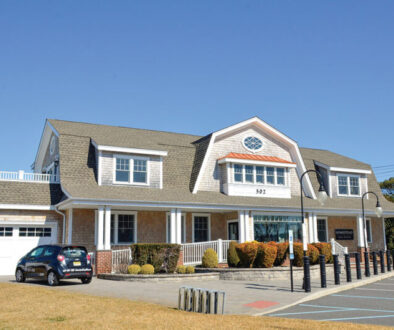Heads of the Glass: Colorful Artistry in Cape May
Life in the Glass Lane
As far back as he can remember, Christopher Michalek has been an artist. But working with stained glass has changed his life.
His father, the late Mike Michalek, was a local porcelain artist who displayed his work throughout New Jersey. “My Dad turned me on to working with stained glass at a very crucial time in my life,” recalls Christopher. At the time, he was working with found objects to make sculptures and he was painting in oils, but Christopher was also personally struggling with alcohol and drugs.
After reading books and watching videos about how to make stained glass, Christopher began experimenting with clear paned glass that he would salvage from dumpsters in Wildwood, New Jersey, where he was working as a chef. For two years, he made clear paned glass boxes, stars, ornaments, abstracts—whatever came to him.
“I figured out that you couldn’t do what I was doing with glass and have a habit, so I kicked the habit,” says Christopher. “Glass has always been really important to me, and art is my love.”
About a year-and-a-half into working with glass, Christopher got a window from a French door that came out of the Candlelight Inn B&B in Wildwood. He removed all the stained glass from it, created an abstract piece, and posted it on Facebook for sale. Twenty minutes later, a woman from Cape May Court House contacted him and bought the piece.
“That window changed my life. Like an idiot, I quit my job and started this stained-glass career,” says Christopher while laughing. “I had high hopes. She’s still one of my best customers.” For the past six years, Christopher has worked solely in stained glass. And his talent has taken him places.
He’s currently working with Barbara Hamilton Bray-Wilde, owner of Willow Creek Farm & Winery in West Cape May, creating an artists co-op. Christopher says that they’re creating the cooperative so that artists will have opportunities to rent their own separate work and arts spaces, so that they can be working and creating while winery visitors can watch them and purchase their wares at the same time.
“It’s going to be an open-air farm market with art, food, music, and everything,” explains Christopher.
This isn’t the first time that Christopher has created places for artists to work. He says he also got artists involved in Seattle, Washington, New York City, and Sussex, New Jersey. Once he brought art and artists to these neighborhoods, he says, other businesses, such as cafes, would settle in the same places. It would all come together.
“That’s my main focus—to create areas where we can generate money to help our communities. I need to make a living, but that’s not something I ever really think about. It just happens,” says Christopher. “I’m here to help people.”
Christopher isn’t working at Willow Creek alone as he is also creating artwork for the grounds; he says that his friend, local artist Carol King Hood, has created images inspired by Alice in Wonderland that he will recreate in glass with lead and copper work. “We’re building a giant throne that’s out of Alice in Wonderland, so whole families can get up and sit in it. It’ll be polished concrete with stained glass inlaid,” explains Christopher. “I asked Barbara what she wanted me to do, and she told me just to dream big.”
Pre-COVID, Christopher spent time bringing art programs to local nursing homes and creating art projects with local kids. With older folks, he would bring glass and glue so that they could create mosaics, and with kids, he would have local carpenters make birdhouses, which the kids could do anything artistic with them. He’s often been able to get companies to donate the supplies for all the art.
In the meantime, he’s also working in a studio in Hamburg, New Jersey at The Gingerbread Castle, a 90-plus-year-old former fairytale-themed playground with a castle on the grounds. “They have hundreds of windows that were done in stained glass. I’ve been commissioned to work and do all their windows,” says Christopher. Currently, he spends two weeks each month working in Cape May and two weeks working in Hamburg.
As if this all doesn’t keep him busy enough, Christopher also continues to make everything from suncatchers to large installations. He just finished making a giant peacock that measures six feet by three feet.
Glass is his life. “Just to stand and look at a piece of glass that somebody put together and the way it glows—the magic behind it is what’s got to me,” he says.
Come to My Window
Lori Erdley doesn’t have any rules about creating her art. As a result, she’s been able to make everything from a bathtub covered in glass to a piece now owned by singer/songwriter Melissa Etheridge.
“I really am across the board,” she admits.
While Lori works with glass, technically her art form is mosaics. She uses stained glass in her work, but that’s not all. She incorporates different kinds—everything from sea glass to recycled glass. Instead of soldering it, as artists typically do when they work with stained glass, she uses grout.
But like Christopher, she does do windows. Her mosaic windows look like stained glass windows; they’re just created differently.
Lori hasn’t been an artist her entire life. In fact, she spent most of her career working for airlines in New York City. About 13 years ago, she got started doing mosaics after she attended a class held at The Mad Batter Restaurant & Bar. That was all she needed.
“I loved it. I just loved the whole tranquility of it—the colors. It brought me back to my childhood because I was an avid sea glass hunter. My father was a beachcomber on Long Island, and I used to go with him. He would be looking for jewels, and I would be looking for sea glass,” says Lori. “So, I always had this connection to colored glass. I went to this class, and it totally triggered my brain into thinking, ‘This is what I need to do.’ I literally filled my garage with tons of glass, and I haven’t looked back since.”
Over the years, Lori has created offbeat commissioned pieces. For example, she made necklaces for a family who came to her with their late mother’s broken Tiffany lamp. She did the same thing with a broken mirror for another family. One customer saw a window of hers in The Mad Batter, and he bought it. But he couldn’t stop there. Although he lives more than three hours from Cape May, he commissioned Lori to make her mosaic windows for his entire home.
“He has me making the eighth one,” says Lori. “His whole house is my art, which is almost like a museum for me. I can’t believe he’s still asking me for more.”
Lori has also made mosaics on mannequins. She’s going to be making one for Stan Sperlak’s Crow Creek Farmsculpture garden in Goshen, which she’s excited about.
Her stint meeting musical royalty came about by happenstance. While driving along one day, Lori found a guitar in the trash. She picked it out, brought it home, and made it into a mosaic.
And then everyone began wanting them.
Lori posted photos of some of the guitars she had made on Instagram, and Melissa Etheridge’s daughter reached out to her saying that she really wanted a gift made for her Mom’s birthday. “She pretty much told me what she wanted, and I made it. That was fun,” says Lori.
But the connection didn’t stop there. Lori and her wife, Lisa Erdley, got to attend a meet-and-greet after one of Etheridge’s concerts. When Lori told Etheridge that she had made the guitar she got for her birthday, it was like something out of a movie. “Her eyes just lit up,” recalls Lori. “She was super excited to meet me, which was really awesome!”
Her mosaic guitars became so popular that Lori was buying wood guitar cutouts. Because they became expensive to buy, Lisa began doing all the wood cutouts. “Now anything that’s a shape, like a mermaid or an anchor, she’ll cut that out for me. Now she’s doing some of the mosaics too,” says Lori.
Lori makes everything from surfboards to dragonflies, from whales to windows, and she does it because of how it makes her feel.
“I do this to make people happy. For me, it’s all about the passion,” she says. “I just feel like I’m touching somebody else’s soul. I like that.”
Dig It
Since he was 20 years old, award-winning tattoo artist Tommy Peters has been digging old bottles—literally. “I love the history behind them,” says Tommy. But his interest in making them into art only began about two years ago.
“My wife and I have always been interested in the Native American History of our area, and we’ve collected artifacts for decades. That’s where my glass creations started,” explains Tommy. “I started making arrowheads with pieces of my broken antique bottles. After a while, I just progressed to different shapes—hearts, stars, and eventually animals.”
While not technically stained-glass pieces, Tommy makes all his art using antique glass bottles that he and his wife dig up from “secret dig spots,” as he says, and he creates each piece by using “hand knapping,” the same traditional methods used by Native Americans for making arrowheads.
“Most times, the glass determines what it’s going to be. I’ve found that green glass is particularly unpredictable, so what may have started as one thing will become something else,” says Tommy. “I think it’s awesome that something so old and discarded can live on as something beautiful!”
Divine Inspiration
If you’ve ever been to a church in Cape May, most likely you’ve seen one of Bruce Hippel’s stained-glass windows. He’s been making them for more than 40 years.
Having lived in Cape May County full-time since 1982, Bruce says, “Sometimes I walk around Cape May and I see a window, and I say, ‘Wow! I forgot I did that!’”
His stained-glass windows are in Our Lady Star of the Sea, Cape May Lutheran Church, and Cape May Presbyterian Church. But Bruce’s windows aren’t just limited to Cape May. He’s made them for churches as far away as Panama City, Florida.
Bruce has created or fixed residential windows as well. In the early 1990s, when the Virginia Hotel was being refurbished, Bruce was asked to redo the eight-foot-tall stained-glass window located past the reception desk. “I took it completely apart and rebuilt it, so it’s still there to this day,” says Bruce. “They actually had a fire, and it survived it because I reinforced the heck out of it.”
Bruce taught himself to do stained glass when he was in his twenties. He had been drawing since he was a kid, but the stained-glass bug hit him when he was visiting a friend in the Germantown neighborhood of Philadelphia. “He was taking apart an old leaded transom piece that used to be very common in the houses there, and I looked at it and I thought, ‘That’s really cool.’ It was almost like I was looking at stained glass for the first time in my life,” says Bruce.
“And so I set upon teaching myself how to do it, and I did.”
While he began doing suncatchers, Bruce moved on to regularly sized windows and up to a 10-foot diameter ceiling dome that had over 5,000 pieces of cut glass.
When making windows for churches, Bruce does a lot of research to make sure the biblical clothing is correct. When his kids were young, he even would use them as part of his preparation. “I used to pose my kids and my wife and myself and anyone else who would pose so that I could use that for my drawings,” recalls Bruce. “I would take a black-and-white photo, and then I would use that as a basis for my drawing.”
Although Cape May has been his home for many decades, Bruce and his wife recently relocated to Charleston, South Carolina to be closer to family. Beforehand, he located the nearest stained-glass studio. He showed them the painted stained-glass work he had done, and they said to get in touch when he moved there.
Of course, he says, he’ll still take commissions from Cape May because, as he says, “I love this place.”
“Stained glass is a powerful medium. It’s more powerful than any other medium because instead of depending on reflected light, it deals with transmitted light, which is always changing as the sunlight changes,” says Bruce. “I’m going to do it until the good Lord tells me I can’t do it anymore.”
Where to find them:
Christopher Michalek: OnFacebook, under his name, and onInstagram @LifeInTheGlassLane @michalekchristopher
Lori Erdley: www.CapeMayRainbowMosaics.com, and on Instagram @CapeMayRainbowMosaics
Tommy Peters: On Facebook at Cape May Sun-Catchers and Art by Tommy and in the Facebook group Cape May Snaps
Bruce Hippel: www.BruceHippelStainedGlass.com
Architectural Uses of Stained Glass in Cape May

A story about glass artists wouldn’t be complete without finding out some of the history about stained glass and Cape May.
“Victorians loved to incorporate glass because they loved to embellish. There was no such thing as too much,” says Mary Stewart, Chief Outreach Specialist at Cape May MAC. “Stained glass is actually just that much better than clear glass, but it also kind of changes the quality of light. It still allows light in, but it changes the warmth of it. It can provide a different kind of ambiance and atmosphere. Also, while stained glass allows you to have light in, it can also obscure a less-than-perfect view. It’s certainly a way that you can sort of make lemonade out of lemons.”
Mary says that stained glass is also used on the sidelights of front doors, transoms on front doors, and on interior transoms, “to allow light to penetrate through the home, throughout the interior of the home.”
She also suggests paying attention to all the stained-glass windows around town. “It’s very interesting to go around Cape May at night because the stained glass is spectacular from the outside in the evening. And look down the alleyways—it’s not always necessarily on the front of the houses. There are lots of side windows that you wouldn’t necessarily notice unless you went looking for them.”
Although Bruce Hippel made some of the stained-glass windows in Our Lady Star of the Sea, Mary says that 40 of them were created by Franz Mayer & Company, the same studio that created the big window over the altar in St. Peter’s Basilica in Rome.
“If you think of this as ‘little Cape May,’” Mary says, “remember it’s got the same windows from the same studios that St. Peter’s Basilica has,” says Mary.







